Page 95 BMW 330CI COUPE 2005 E46 Owner's Manual
[x] Cancel search | Manufacturer: BMW, Model Year: 2005, Model line: 330CI COUPE, Model: BMW 330CI COUPE 2005 E46Pages: 190, PDF Size: 2.79 MB
Page 4 of 190
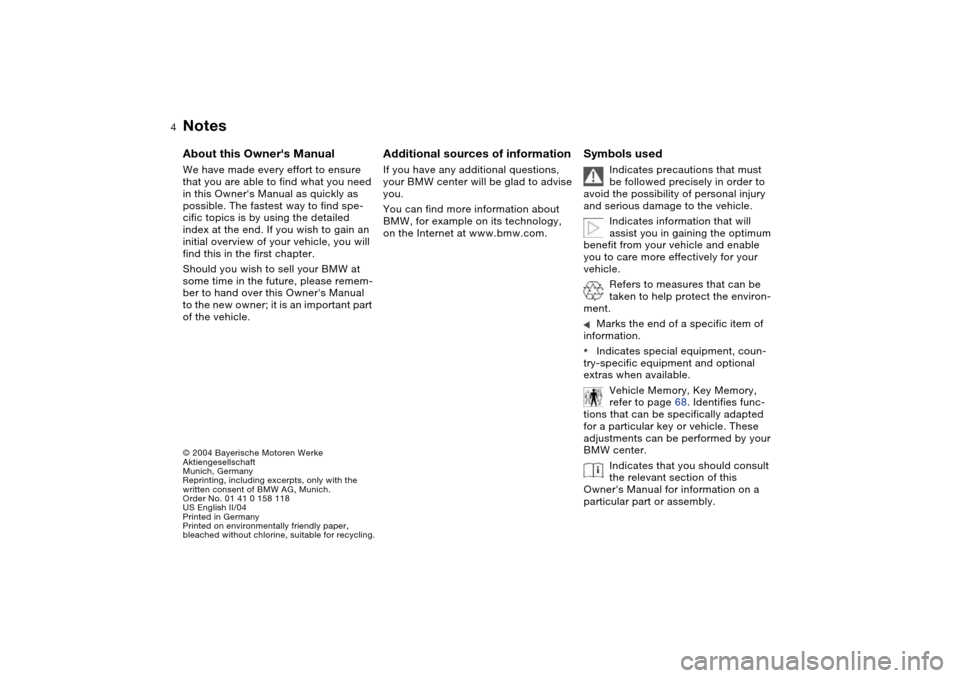
4
Notes
© 2004 Bayerische Motoren Werke
Aktiengesellschaft
Munich, Germany
Reprinting, including excerpts, only with the
written consent of BMW AG, Munich.
Order No. 01 41 0 158 118
US English II/04
Printed in Germany
Printed on environmentally friendly paper,
bleached without chlorine, suitable for recycling.
About this Owner's Manual
We have made every effort to ensure
that you are able to find what you need
in this Owner's Manual as quickly as
possible. The fastest way to find spe-
cific topics is by using the detailed
index at the end. If you wish to gain an
initial overview of your vehicle, you will
find this in the first chapter.
Should you wish to sell your BMW at
some time in the future, please remem-
ber to hand over this Owner's Manual
to the new owner; it is an important part
of the vehicle.
Additional sources of information
If you have any additional questions,
your BMW center will be glad to advise
you.
You can find more information about
BMW, for example on its technology,
on the Internet at www.bmw.com.
Symbols used
Indicates precautions that must
be followed precisely in order to
avoid the possibility of personal injury
and serious damage to the vehicle.
Indicates information that will
assist you in gaining the optimum
benefit from your vehicle and enable
you to care more effectively for your
vehicle.
Refers to measures that can be
taken to help protect the environ-
ment.
Marks the end of a specific item of
information.
Indicates special equipment, coun-
try-specific equipment and optional
extras when available.
Vehicle Memory, Key Memory,
refer to page 68. Identifies func-
tions that can be specifically adapted
for a particular key or vehicle. These
adjustments can be performed by your
BMW center.
Indicates that you should consult
the relevant section of this
Owner's Manual for information on a
particular part or assembly.
Page 18 of 190

18
Indicator and warning lamps
Technology that monitors itself
Indicator and warning lamps that are
identified by
●
are tested for proper
functioning whenever the ignition key is
turned. They each light up once for dif-
ferent periods of time.
If a fault should occur in one of these
systems, the corresponding lamp does
not go out after the engine is started, or
it lights up while the vehicle is moving.
You will see how to react in the follow-
ing section.
Red: stop immediately
Battery charge current
●
The battery is no longer being
charged. Indicates a defective
alternator drive belt or a problem with
the alternator's charge circuit. please
contact the nearest BMW center.
If the drive belt is defective, stop
and switch off the engine immedi-
ately to prevent overheating and seri-
ous engine damage. If the drive belt is
defective, increased steering effort is
also required.
<
Engine oil pressure
●
The engine oil pressure is too
low. Stop the vehicle immedi-
ately and switch off the engine. It is not
possible to continue driving. Please
contact the nearest BMW center.
Do not continue driving, as the
engine could sustain serious dam-
age from inadequate lubrication.
<
Flat Tire Monitor
●
In addition, an acoustic signal is
sounded: there is a flat tire.
Reduce speed and carefully come to a
stop. Avoid sudden braking and steer-
ing maneuvers.
For additional information, refer to
page 93.
Brake warning lamp
●
If the lamp comes on when the
parking brake is not engaged:
check the brake fluid level. It is very
important that you follow the instruc-
tions on page 145 before driving on.
Have the system checked immediately.
Brake warning lamp for Cana-
dian models.
Red and yellow: continue driving
cautiously
The brake warning lamp comes
on together with the yellow indi-
cator lamps for ABS
●
and DSC:
The entire ABS, CBC and DSC
control system has failed. Con-
tinue driving cautiously and
defensively. Avoid full brake
applications. Please have the
system checked by your BMW center
as soon as possible.
Additional information beginning on
page 91.
CBC, ABS and DSC and DBC
indicator and warning lamps for
Canadian models.
Red: an important reminder
Brake warning lamp
Comes on when the parking
brake is engaged – an additional
acoustic signal sounds when you start
off.
For additional information, refer to
page 71.
Page 19 of 190

19
Brake warning lamp for Cana-
dian models.
Lock backrest/Fasten safety
belts
●
Comes on together with an
acoustic signal until the safety belts are
fastened. Flashes if the backrest is not
locked.
For additional information on locking
the seat backrests, refer to page 53.
For additional information on safety
belts, refer to page 54.
Airbags
●
Have the system checked as
soon as possible.
For additional information, refer to
page 61.
Orange: consult the nearest BMW
center
Automatic transmission/sequen-
tial manual gearbox
The respective transmission has
responded to a malfunction by reverting
to operation in its emergency default
program. Have the system checked
immediately.
For additional information, refer to
pages 75, 79.
Yellow: check as soon as possible
Engine oil level
If the lamp comes on during
normal vehicle operation: the
engine oil level has fallen to the abso-
lute minimum; refill as soon as possible.
Do not drive more than approx.
30 miles/50 km before refilling.
For additional information, refer to
page 142.
Engine oil level
Comes on after the engine has
been switched off: add engine
oil at the earliest opportunity, such as
the next time you stop to refuel.
For additional information, refer to
page 142.
Brake pads
●
Have the brake pads checked
immediately.
For additional information, refer to
page 126.
Flat Tire Monitor
●
The Flat Tire Monitor is malfunc-
tioning or out of order. If there is
a malfunction, have the system
checked. For additional information,
refer to page 94.
Dynamic Stability Control
(DSC)
●
Indicator lamp flashes:
The system is actively regulating drive
torque and braking force.
The indicator lamp stays lit:
DSC has been switched off with the
button; DTC is operational.
If there is a malfunction, have the sys-
tem checked as soon as possible.
Additional information beginning on
page 91.
Dynamic Stability Control (DSC)
and brake warning lamp
●
The indicator lamps remain on:
DSC/DTC have been switched
off with the button or are faulty.
If there is a malfunction, have
the system checked as soon as possi-
ble.
Additional information beginning on
page 91.
DSC indicator and brake warn-
ing lamps for Canadian models.
Indicator and warning lamps
OverviewControlsMaintenanceRepairsDataIndex
Page 20 of 190
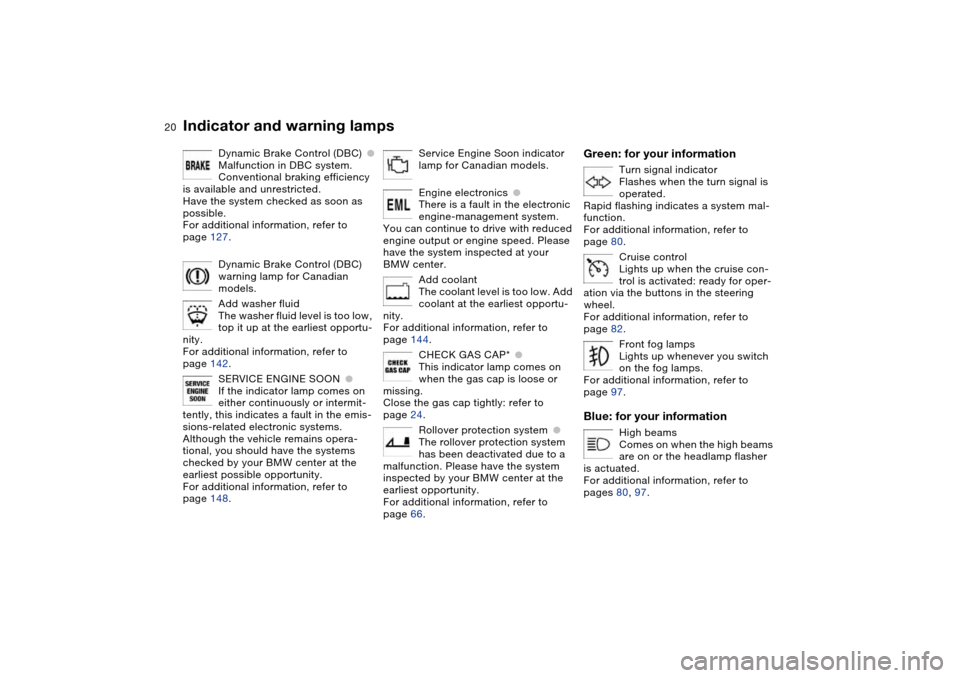
20
Dynamic Brake Control (DBC)
●
Malfunction in DBC system.
Conventional braking efficiency
is available and unrestricted.
Have the system checked as soon as
possible.
For additional information, refer to
page 127.
Dynamic Brake Control (DBC)
warning lamp for Canadian
models.
Add washer fluid
The washer fluid level is too low,
top it up at the earliest opportu-
nity.
For additional information, refer to
page 142.
SERVICE ENGINE SOON
●
If the indicator lamp comes on
either continuously or intermit-
tently, this indicates a fault in the emis-
sions-related electronic systems.
Although the vehicle remains opera-
tional, you should have the systems
checked by your BMW center at the
earliest possible opportunity.
For additional information, refer to
page 148.
Service Engine Soon indicator
lamp for Canadian models.
Engine electronics
●
There is a fault in the electronic
engine-management system.
You can continue to drive with reduced
engine output or engine speed. Please
have the system inspected at your
BMW center.
Add coolant
The coolant level is too low. Add
coolant at the earliest opportu-
nity.
For additional information, refer to
page 144.
CHECK GAS CAP*
●
This indicator lamp comes on
when the gas cap is loose or
missing.
Close the gas cap tightly: refer to
page 24.
Rollover protection system
●
The rollover protection system
has been deactivated due to a
malfunction. Please have the system
inspected by your BMW center at the
earliest opportunity.
For additional information, refer to
page 66.
Green: for your information
Turn signal indicator
Flashes when the turn signal is
operated.
Rapid flashing indicates a system mal-
function.
For additional information, refer to
page 80.
Cruise control
Lights up when the cruise con-
trol is activated: ready for oper-
ation via the buttons in the steering
wheel.
For additional information, refer to
page 82.
Front fog lamps
Lights up whenever you switch
on the fog lamps.
For additional information, refer to
page 97.
Blue: for your information
High beams
Comes on when the high beams
are on or the headlamp flasher
is actuated.
For additional information, refer to
pages 80, 97.
Indicator and warning lamps
Page 28 of 190
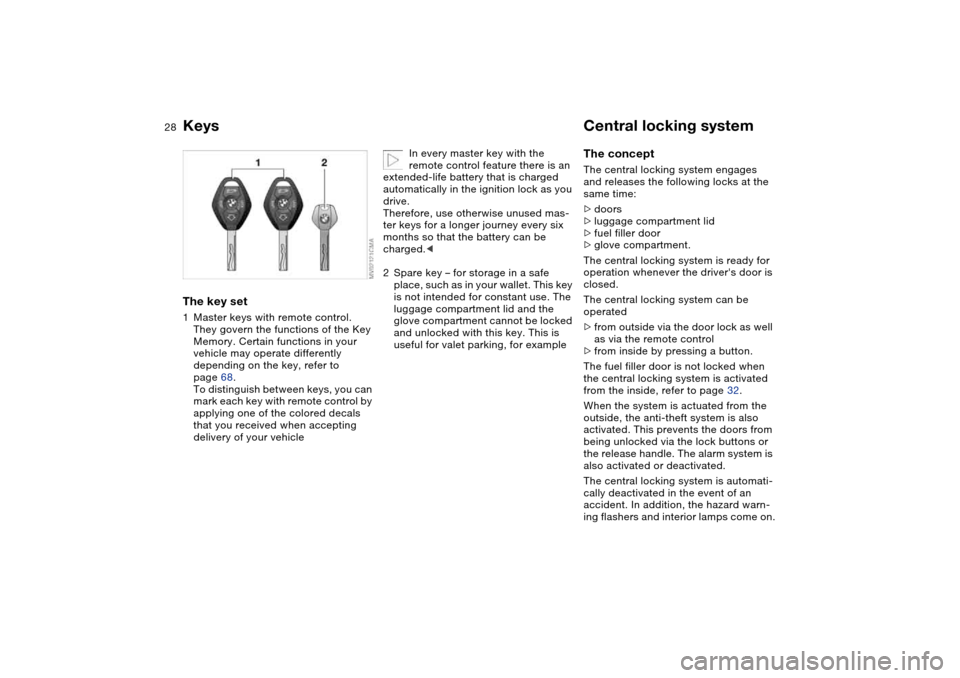
28Opening and closing
KeysThe key set1Master keys with remote control.
They govern the functions of the Key
Memory. Certain functions in your
vehicle may operate differently
depending on the key, refer to
page 68.
To distinguish between keys, you can
mark each key with remote control by
applying one of the colored decals
that you received when accepting
delivery of your vehicle
In every master key with the
remote control feature there is an
extended-life battery that is charged
automatically in the ignition lock as you
drive.
Therefore, use otherwise unused mas-
ter keys for a longer journey every six
months so that the battery can be
charged.<
2Spare key – for storage in a safe
place, such as in your wallet. This key
is not intended for constant use. The
luggage compartment lid and the
glove compartment cannot be locked
and unlocked with this key. This is
useful for valet parking, for example
Central locking systemThe conceptThe central locking system engages
and releases the following locks at the
same time:
>doors
>luggage compartment lid
>fuel filler door
>glove compartment.
The central locking system is ready for
operation whenever the driver's door is
closed.
The central locking system can be
operated
>from outside via the door lock as well
as via the remote control
>from inside by pressing a button.
The fuel filler door is not locked when
the central locking system is activated
from the inside, refer to page 32.
When the system is actuated from the
outside, the anti-theft system is also
activated. This prevents the doors from
being unlocked via the lock buttons or
the release handle. The alarm system is
also activated or deactivated.
The central locking system is automati-
cally deactivated in the event of an
accident. In addition, the hazard warn-
ing flashers and interior lamps come on.
Page 29 of 190

29
Opening and closing – via the remote controlThe conceptThe remote control also provides two
additional functions beyond the central
locking feature:
>To switch on interior lamps, refer to
page 30.
With this function you can also
search for the vehicle when parked in
an underground garage, for instance
>To open the luggage compartment
lid, refer to page 30.
The luggage compartment lid will
open slightly, regardless of whether it
was previously locked or unlocked.
Whenever you unlock or lock the vehi-
cle, you simultaneously deactivate/acti-
vate the anti-theft system, disarm/arm
the alarm system and switch the interior
lamps on/off.
You can have a signal set to con-
firm that the vehicle's locks have
engaged securely.<
Master keys with remote control
Persons or animals inside the
vehicle may be able to lock the
doors from the inside. For this reason,
you should always take the vehicle keys
with you so that the vehicle can be
opened again from the outside at any
time.<
If it is no longer possible to lock
the vehicle via the remote control,
the battery is discharged. Use this key
while driving for an extended period in
order to recharge the battery.
To prevent unauthorized use of the
remote control, surrender only the
spare key when leaving the vehicle for
valet parking, for example.
In the event of a system malfunction,
please contact your BMW center. You
can also obtain replacement keys
there.<
1Unlock, convenience opening mode,
and disarm alarm system
2Lock and secure, arm alarm system,
activate interior lamps, disarm tilt
alarm sensor and interior motion sen-
sor
3Open the luggage compartment lid,
Panic mode – trigger alarmTo releasePress the button once to unlock the
driver's door.
Press the button a second time to
disengage all vehicle locks.<
OverviewControlsMaintenanceRepairsDataIndex
Page 33 of 190
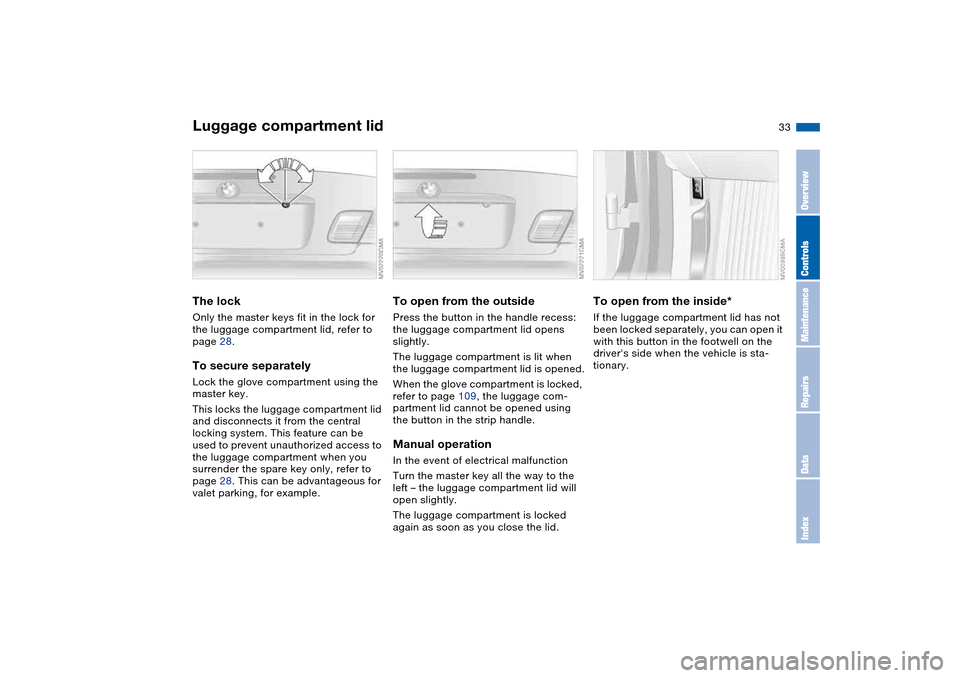
33
Luggage compartment lidThe lockOnly the master keys fit in the lock for
the luggage compartment lid, refer to
page 28.To secure separatelyLock the glove compartment using the
master key.
This locks the luggage compartment lid
and disconnects it from the central
locking system. This feature can be
used to prevent unauthorized access to
the luggage compartment when you
surrender the spare key only, refer to
page 28. This can be advantageous for
valet parking, for example.
To open from the outsidePress the button in the handle recess:
the luggage compartment lid opens
slightly.
The luggage compartment is lit when
the luggage compartment lid is opened.
When the glove compartment is locked,
refer to page 109, the luggage com-
partment lid cannot be opened using
the button in the strip handle.Manual operationIn the event of electrical malfunction
Turn the master key all the way to the
left – the luggage compartment lid will
open slightly.
The luggage compartment is locked
again as soon as you close the lid.
To open from the inside*If the luggage compartment lid has not
been locked separately, you can open it
with this button in the footwell on the
driver's side when the vehicle is sta-
tionary.
OverviewControlsMaintenanceRepairsDataIndex
Page 34 of 190
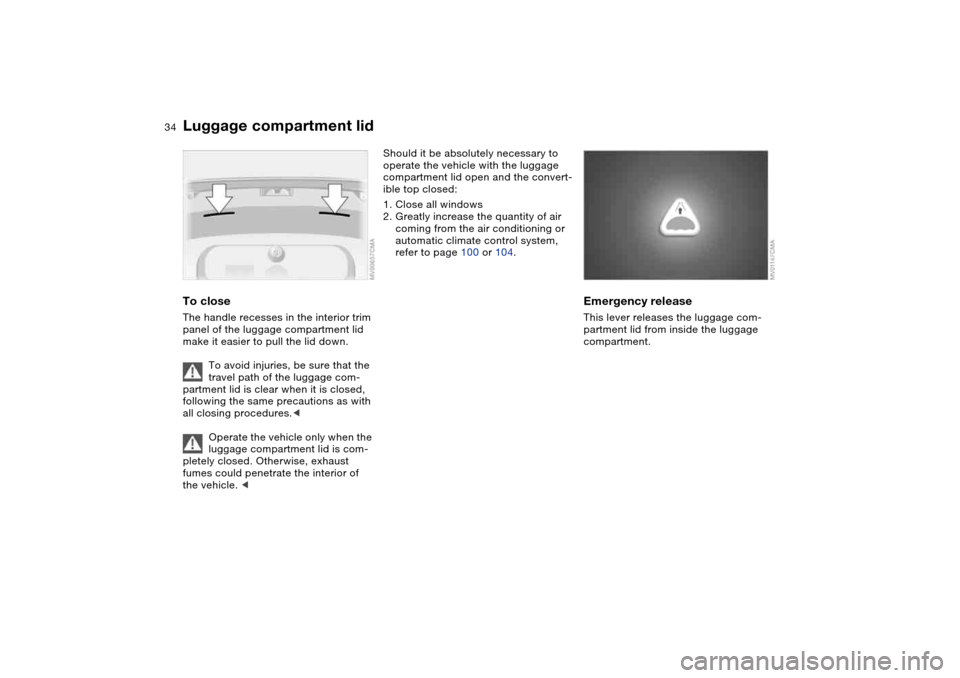
34
To closeThe handle recesses in the interior trim
panel of the luggage compartment lid
make it easier to pull the lid down.
To avoid injuries, be sure that the
travel path of the luggage com-
partment lid is clear when it is closed,
following the same precautions as with
all closing procedures.<
Operate the vehicle only when the
luggage compartment lid is com-
pletely closed. Otherwise, exhaust
fumes could penetrate the interior of
the vehicle. <
Should it be absolutely necessary to
operate the vehicle with the luggage
compartment lid open and the convert-
ible top closed:
1. Close all windows
2. Greatly increase the quantity of air
coming from the air conditioning or
automatic climate control system,
refer to page 100 or 104.
Emergency releaseThis lever releases the luggage com-
partment lid from inside the luggage
compartment.
Luggage compartment lid
Page 35 of 190
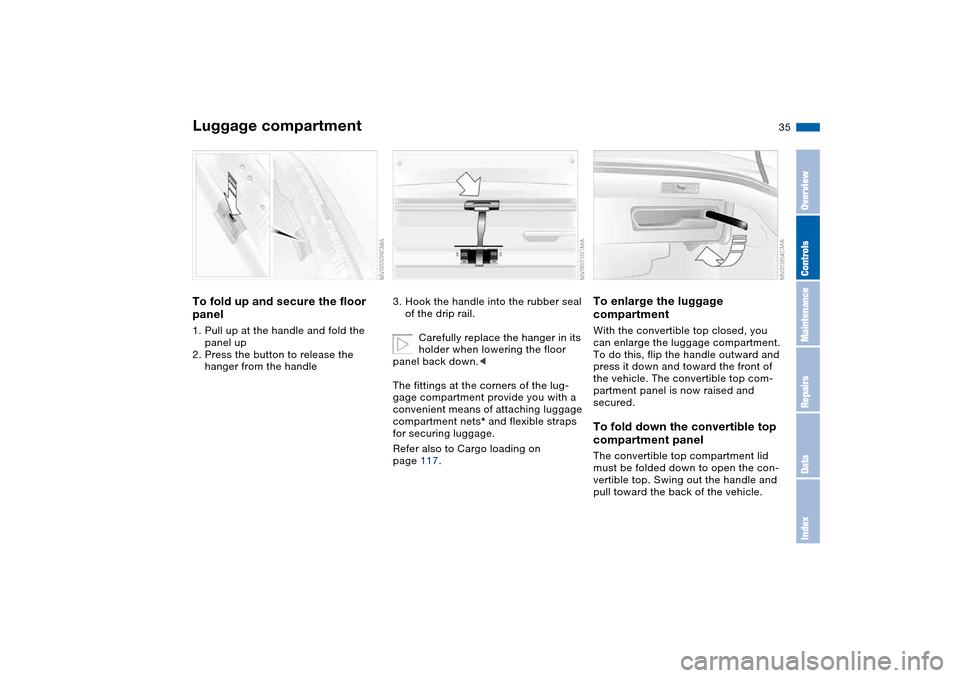
35
Luggage compartmentTo fold up and secure the floor
panel1. Pull up at the handle and fold the
panel up
2. Press the button to release the
hanger from the handle
3. Hook the handle into the rubber seal
of the drip rail.
Carefully replace the hanger in its
holder when lowering the floor
panel back down.<
The fittings at the corners of the lug-
gage compartment provide you with a
convenient means of attaching luggage
compartment nets* and flexible straps
for securing luggage.
Refer also to Cargo loading on
page 117.
To enlarge the luggage
compartmentWith the convertible top closed, you
can enlarge the luggage compartment.
To do this, flip the handle outward and
press it down and toward the front of
the vehicle. The convertible top com-
partment panel is now raised and
secured.To fold down the convertible top
compartment panelThe convertible top compartment lid
must be folded down to open the con-
vertible top. Swing out the handle and
pull toward the back of the vehicle.
OverviewControlsMaintenanceRepairsDataIndex
Page 36 of 190
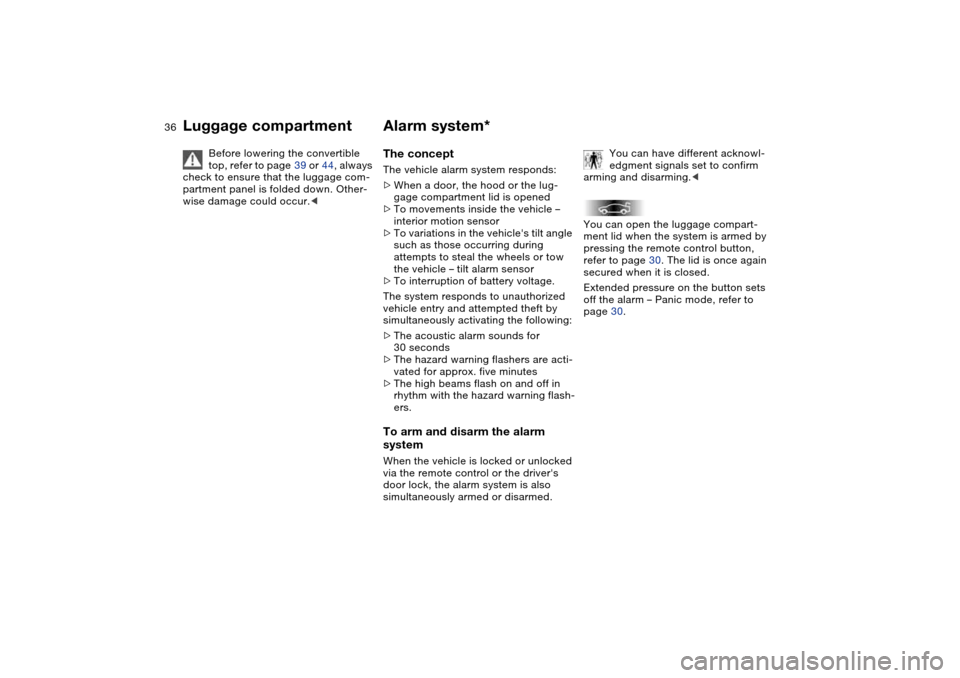
36
Before lowering the convertible
top, refer to page 39 or 44, always
check to ensure that the luggage com-
partment panel is folded down. Other-
wise damage could occur.<
Alarm system*The conceptThe vehicle alarm system responds:
>When a door, the hood or the lug-
gage compartment lid is opened
>To movements inside the vehicle –
interior motion sensor
>To variations in the vehicle's tilt angle
such as those occurring during
attempts to steal the wheels or tow
the vehicle – tilt alarm sensor
>To interruption of battery voltage.
The system responds to unauthorized
vehicle entry and attempted theft by
simultaneously activating the following:
>The acoustic alarm sounds for
30 seconds
>The hazard warning flashers are acti-
vated for approx. five minutes
>The high beams flash on and off in
rhythm with the hazard warning flash-
ers.To arm and disarm the alarm
systemWhen the vehicle is locked or unlocked
via the remote control or the driver's
door lock, the alarm system is also
simultaneously armed or disarmed.You can have different acknowl-
edgment signals set to confirm
arming and disarming.<
You can open the luggage compart-
ment lid when the system is armed by
pressing the remote control button,
refer to page 30. The lid is once again
secured when it is closed.
Extended pressure on the button sets
off the alarm – Panic mode, refer to
page 30.
Luggage compartment